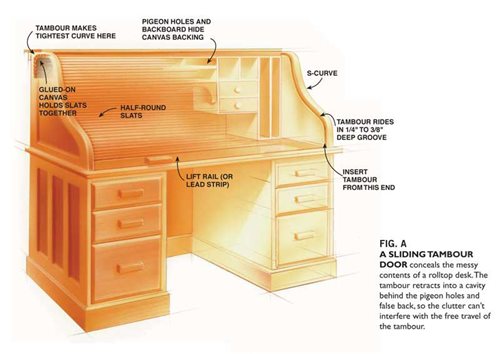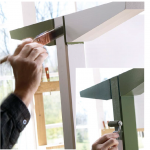We may receive a commission when you use our affiliate links. However, this does not impact our recommendations.

Tambour Doors
Disappearing doors hide your clutter and show off your skill.
Tambour doors are a bit of woodworking sleight of hand. Now you see them, now you don’t. Fun to open and fun to close, tambours invite you to play with your furniture. Designing a tambour can be fun, too, because you’ll have to build a full-size model of the door to work out the details.
Use tambour doors wherever regular doors are too large or too awkward. A tambour can cover a wide opening without having to swing out like a regular door. It never gets in your way. You can open a single tambour to reach the entire contents of a cabinet, rather than open multiple standard doors. A cabinet with an open tambour has a clean, contained look, rather than the busy look of a cabinet with open doors.
Start your project by carefully designing the doors. The shape and size of the slats will determine the diameters of the curves that the tambour will follow. Next, design a cavity to hold the tambour. This is where you play the part of a magician. Finally, draw out a case that will contain the curves and cavity. This may seem like designing furniture backwards, but you’ll find this method does put the horse before the cart!
A tambour door has three parts—the slats, a canvas backing and a thicker rail or stile to pull the whole assembly. A tambour can run up and down or side to side, and pass through either an Scurve or a simple-radius C-curve. Let’s look at two classic examples of how tambours have been used: a turn of the century rolltop desk and an early 19th-century Federal desk.
An S-Curve Gives Strength
A rolltop desk with sides curved in the shape of a lazy S is a familiar icon (Fig. A). The tambour runs down behind the pigeon holes and false back into a narrow cavity. The false back is an essential part of all tambour design. Without it, you’d see the canvas backing of the tambour. Moreover, clutter on the desk might block the tambour from opening all the way.
There’s more to the S-curve design than meets the eye. Its pleasing curve has two practical benefits (Fig. B). Bending the tambour into a reverse curve actually stiffens it, which prevents the slats from drooping in the center of a wide desk. To prove this to yourself, hold up a piece of paper and form it into the shape of an S-curved tambour. Flatten out the curve and the paper will droop.
A tambour has to flex both forward and backward to pass through an S-curve. Half-round and bevel-edged slats are traditional designs that can accomplish this (Fig. C).
The slats in an S-curve tambour can be thinner and lighter in weight than those needed to stiffen a tambour that isn’t curved. Yet another feature of an Scurved tambour is that it’s less likely to come crashing down when you close it!
Sizing S-Curve Slats
Design your rolltop tambour on a full-scale drawing. Use a piece of paper as large as the end of the desk to work out the shape of the S-curve, the size of the pigeon hole section and the placement of the false back.
Draw the groove parallel to the curved side. It’s easiest to make its width the same size as a router bit. Then make the slats a little bit thinner than the groove so they can move freely along it.
The thickness of the slats depends on the distance they have to span. Slats range from a bit less than 3⁄4-in. thick for a 60-in. opening down to 5⁄16-in. thick for a 24-in. opening.
How wide should the slats be? Their width is limited by the sharpest turn the tambour has to make (Fig. D). In a rolltop, that turn is hidden. It’s at the back of the desk, behind the pigeon holes.
Build a Model
Sizing the width and thickness of the slats can’t be done on paper alone, however. You have to test the real thing.
Rout a groove into a piece of plywood, following a template. Make a few short tambour slats and glue them on to a piece of canvas. Try running the mock tambour through the groove. If it’s too loose, your tambour will make an unpleasant rattling sound. If it’s even a shade too tight, the tambour may not move in humid weather. The right fit can be elusive, but the only way to find it is to build a model.
The Lift Rail
A large rolltop tambour needs a heavyduty, multi-purpose lift rail. The lift rail absorbs the shock of the tambour closing on the desktop. Its extra width and thickness help the tambour glide through the grooves without buckling, give you enough room to install a mortised lock and provide a surface large enough to hold a comfortable handle.
Design the handle and buy the lock before choosing the size of your lift rail. They’re generally 2- to 3-in. wide.
Cut a tongue on the ends of the rail so it can slide through the grooves (Fig. E). The tongue is thinner and wider than the slats. Try running a mock lift rail through the S-curve. It doesn’t have to negotiate the tight turn behind the pigeon holes because you can install the completed tambour from the front of the desk.
Turning Tight C-Curves
Let’s turn to the Federal desk, where the tambour moves across the face of a cabinet to make two C-shaped turns at each end (Fig. F). This tambour disappears like magic into a cavity between the outer cabinet and an inner box that contains pigeon holes or shelves. Because it only bends in one direction, the tambour can have flat faces. When closed it will look like a flat panel, unlike the ribbed surface of the rolltop desk tambour.
Often the trick here is to design a tambour that can make a very tight turn. A wide turn would require large, awkward-looking stiles at the sides of the cabinet. The secret is to put small, invisible tongues on all the slats (Fig. G). The smaller the slat, the smaller the tongue, and the tighter the radius the tambour can turn.
Unequal shoulders to the tongues are important for the tambour to glide smoothly through the groove. The back shoulder should be very narrow (or eliminated altogether) to bring the canvas backing in line with the curve (Fig. H).
The tambour rides on the end of its tongues, not on the shoulders (Fig. J), so that opening and closing the tambour won’t wear down the finish on the cabinet. Cut the tongues just a bit longer than the groove is deep.
You may dispense with a lift rail, because you’re not fighting gravity. However, if you want the door to lock or need more room for a handle, you can make a lead strip that’s larger than the slats (Fig. K). It doesn’t have to negotiate the tight C-curves. Insert the finished tambour from the rear of the cabinet and attach a two-part lead strip to the tambour after it has passed through the turns.
Source
Note: Product availability and prices are subject to change.
Custom-made and commercial tambours are available from National Products. Call 800-228-5276 for a distributor in your area.
This story originally appeared in American Woodworker December 1999, issue #77.
Here are some supplies and tools we find essential in our everyday work around the shop. We may receive a commission from sales referred by our links; however, we have carefully selected these products for their usefulness and quality.













